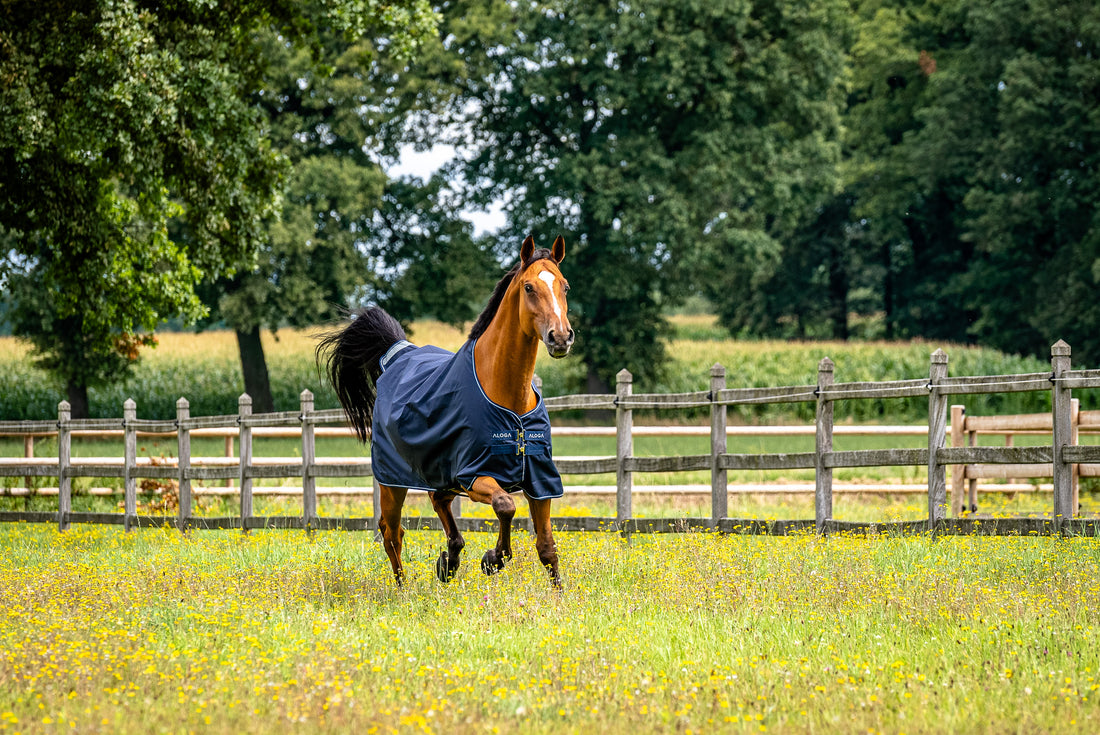Blanketing 101: As summer fades to autumn one of the most common questions we are faced as horse owners is when to blanket our horses. If we do decide to blanket during September then which blanket is best for our horse when we are getting all four seasons in a day! Transitional weather, particularly in autumn, can be tricky to navigate as temperatures fluctuate from warm or wet days to chilly nights. Too much warmth can lead to overheating, while too little can leave your horse exposed to dramatic weather changes. So, how do we decide when and how to blanket during unpredictable September weather?
In this blog, we’ll look at some of the factors you should consider to help make an informed decisions to keep your horse comfortable no matter how many seasons we get in a day!
WATCH THE WEATHER PATTERNS:
Horses are generally quite resilient to cold temperatures, thanks to their natural adaptations like thick winter coats and the ability to generate heat by digesting fibrous food. However, they can start to feel the effects of cold temperatures at around 4°C to 10°C (40°F to 50°F), depending on factors like their coat, health, and environment.
HOW DIFFERENT TEMPERATURE RANGES AFFECT YOUR HORSE:
10°C (50°F) AND ABOVE: Most horses are comfortable without a blanket unless they are clipped or very sensitive to cold. If it’s rainy or windy, some horses can start feeling cold due to the wind chill being enhanced if their coat is wet.
4°C to 10°C (40°F to 50°F): Some horses, particularly those that are clipped, underweight, or elderly, may start to feel the chill, especially if the weather is damp or windy. Others with a thicker, full winter coats may still be comfortable without a blanket.
BELOW 4°C (40°F): This is when you need to pay closer attention. Most horses with full winter coats can handle this temperature well, but those without natural protection such as clipped horses or those with thin coats may need to be blanketed, especially if the weather is wet or windy.
BELOW -7°C (20°F): Horses are more likely to feel the effects of the cold and may benefit from medium to heavy-weight blankets, particularly those who are not acclimatized to such temperatures or lack natural protection.
Wind and wet conditions can make temperatures feel colder than they are, so you may need to blanket at higher temperatures than you would otherwise if it's rainy or windy. Ultimately as a horse owner regular monitoring and assessment of your horse’s individual behaviour is key to making the right decision when blanketing during the autumn season as each horse has different tolerance to cold and wet conditions.
THE BEST ALOGA BLANKETS FOR CHANGING AUTUMN WEATHER
Having the right types of blankets for different weather conditions is key. Here's are the Aloga blankets designed to be used during transitional seasons:
Fly Dry Sheet: The Fly Dry Sheet is an ideal choice for horses facing warm, wet, changeable days. This hybrid style lightweight blanket is designed to complement how your horse naturally heats and cools themselves. A contour cut chest, and top section maps your horse’s back & quarters, areas of key muscle groups. Horses tend to lose heat from these areas. Made with breathable 600D Ripstop polyester this top section acts to keep your horse dry during unexpected showers helping to keep their temperature regulated and protect their coat.
Side sections of this blanket are constructed from breathable knitted polyester mesh to allow for optimal airflow. Shoulder and belly areas can be prone to overheating so enhancing breathability of the side sections helps to prevent your horse from overheating if temperatures start to climb during autumn days.
ALOGA 0G TURNOUT: Our 0g turnouts are ideal for cool but not cold weather, especially when it’s windy or wet. What makes our blankets ideal for transitional weather is the easy-to-use liner loops. These make the Aloga 0g blankets flexible as additional weight Aloga Liners can be added later in the season as temperature drops stabilise. For cool, wet days and chilly nights the outer fabric offers waterproof protection constructed from 600D ripstop polyester. This blanket is durable, waterproof, and breathable solution to milder, wet days in turnout and will help keep coats clean and dry.
As we reach the September mid point, blanketing horses during this transitional weather requires your attention to your horse’s specific needs and the daily weather patterns. Staying flexible, monitoring your horse's condition, and having a variety of blanket options like the Fly Dry Sheet or Aloga 0g Turnout will help you keep your horse comfortable during these unpredictable days.


1 comment
Can we buy saddlepads and hoods?